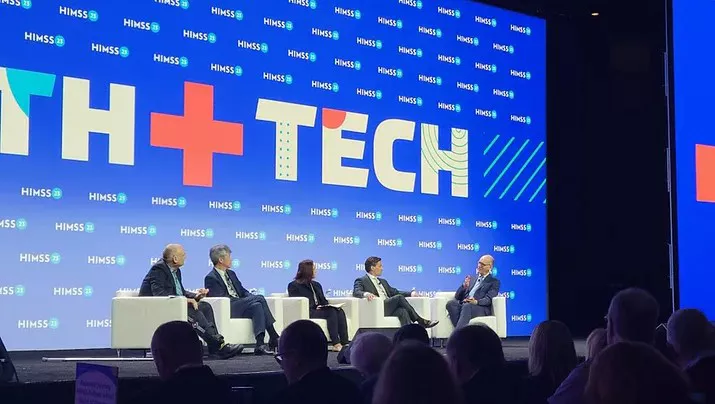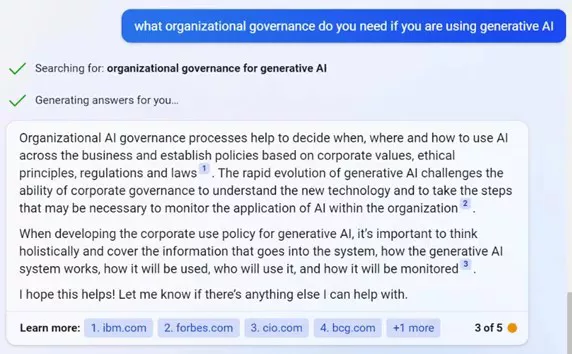Five AI questions every healthcare CIO should ask
 Leaders from Microsoft, Mayo Clinic, Virtue, and the World Economic Forum share perspectives on Responsible AI during the opening keynote of HIMSS23.
Leaders from Microsoft, Mayo Clinic, Virtue, and the World Economic Forum share perspectives on Responsible AI during the opening keynote of HIMSS23.
Every few years, a new technology creates so much potential that it transcends the trend moniker to become a movement. Energy permeates the industry as innovators race to convert technical breakthroughs into new value, and leaders suddenly realize that there will be a tangible before and after this moment in our collective human experience.
Generative AI is one of those technologies.
Generative AI dominated the conversation at the 2023 Healthcare Information and Management Systems Society (HIMSS23) conference. Health IT leaders shared stories of early successes, warned audiences of ethical risks, and explored the potential for a more intelligent, human-centered healthcare ecosystem.
“We’re watching history take place,” said Kay Firth-Butterfield, Head of Artificial Intelligence for the World Economic Forum. However, she advised healthcare leaders to proceed with caution.
“We are hurdling into the future without taking a step back and designing it for ourselves,” she said, commenting on the open letter to Pause Giant AI Experiments. “Make sure that everyone in your company knows something about AI, and don’t engage without some understanding of the responsible AI issue.”
Getting started with AI in healthcare
As the 35,000 HIMSS participants returned home to their daily responsibilities, one question was on everyone’s mind: What should we be doing with AI in healthcare?
Here are five questions to start your healthcare AI journey.
1. Where are we using AI successfully today?
While generative AI has unlocked incredible potential in healthcare, most health organizations have been using some form of artificial intelligence for decades. Take inventory of where you are using AI today, conduct a quick SWOT analysis to identify risks and opportunities, and evaluate the potential to optimize and scale your existing operating model, infrastructure, and assets for expanded AI use cases.
2. What challenges or strategic priorities can be best addressed through AI?
With AI dominating the industry news, health IT leaders are facing increasing pressure from C-suite executives and board members to share how they are using AI in their organizations. The allure of generative AI can be tempting, but HIMSS speakers urged leaders to think carefully before implementing point solutions.
“This is the fourth or fifth gigantic hype cycle for AI,” said Deborah DiSanzo, President of Best Buy Health. “We can’t solve point solutions—we have to solve workflow, operations—we have to think about the entire solutions.”
One way to avoid the ‘point solution trap’ is to conduct an Art of the Possible workshop to review strategic priorities, identify potential AI-enabled solutions, and prioritize high-impact/low-effort initiatives to gain quick but meaningful wins. This analysis should incorporate an understanding of all touchpoints with members/patients, consumers, and internal team members, taking a systems thinking approach to looking at the entire value chain both outwardly and inwardly to identify opportunities.
More often than not, organizations gain the biggest ROI by focusing on reducing administrative burden and improving existing workflows vs. more disruptive clinical innovations.
3. Do we have the cloud and data infrastructure necessary to enable AI/ML solutions?
A foundation of high-quality, extensible data is critical to revealing actionable and unbiased insights and enabling AI/ML at scale. However, many health organizations still lack robust and interoperable data platforms.
“You can’t do anything with AI without good data,” said Firth-Butterfield. “The amount, quality, and origin of data are pernicious, ethical questions that we’re going to have to answer in the future.”
If you haven’t already, take a critical look at your Data Science Operating Model and consider evolving toward a data mesh architecture to enable consumable data products. Depending on the size of your organization, your AI/ML strategy may also depend on integrating real-world data from outside sources to reach meaningful scale.
4. How do we jumpstart our AI engine—with an eye toward scaling for outcomes?
Despite widespread calls for vigilance, the call to action for health IT leaders was clear: Start now.
“Don’t wait for a small number of experts in Silicon Valley and Carnegie Melon to do this,” said Christopher Ross, Chief Information Officer at the Mayo Clinic. “Make sure you have people with the expertise to develop use cases and manage products.”
David Higginson, Chief Innovation Officer at Phoenix Children’s Hospital, said to start with the end in mind.
“Science projects that never make it out of the lab don’t save lives,” he said. “Once you have an idea, ask the operators what they would do and how they would do it.”
Perhaps most importantly, establish the operating model to support continuous learning, discovery, development, and scale.
“It only matters if we have the operating model to do something with the data,” said Tim Barry, CEO of VillageMD. “If you’re not thinking about people and where they are, you’re moving your business in the wrong way.”
5. How will we protect the integrity of our people and the dignity of our patients?
In the opening keynote, speakers described the generative AI as mysterious, awe-inspiring, and frustrating.
“There are still deep scientific issues that we’re just trying to come to grips with in addition to the ethical questions,” said Peter Lee, Corporate Vice President of Research and Incubation at Microsoft. “Generative AI is emerging in a way that is just ready for deployment, but it’s not simple.”
Unlike traditional AI, generative AI is a “leapfrog” technology that allows individuals and organizations with no prior experience to get started immediately. This presents both tremendous opportunity and significant risks for healthcare organizations. As Microsoft Bing explains, “The rapid evolution of generative AI challenges the ability of corporate governance to understand the new technology and to take the steps that may be necessary to monitor the application of AI within the organization.”

Some topics to consider include informed consent, customer preferences, data privacy and security, compliance, accountability, and equity. Embedding AI governance into existing forums or creating new forums to address the nuances of responsible AI will be critical for every healthcare organization in our intelligent future.
Health that connects + tech that cares
Beyond the possibilities and perils of AI, HIMSS23 pulsated with a community of dreamers, designers, and developers who share a common mission to “reform the global health ecosystem through the power of information and technology.”
Regardless of whether you choose to become an AI pioneer or fast follower, we all have a role in advancing fiercely human healthcare.
“The technology we pick will have an impact on every member of the world and every one of our individual communities,” said Dr. Hans Kluge, WHO Regional Director for Europe. “Together we can open up new horizons and realize the full health potential of every human, everywhere.”
Contributors
Matt Dubay, John Poling, Ellie Rice
This blog post was originally published here.



